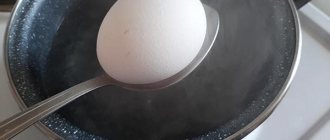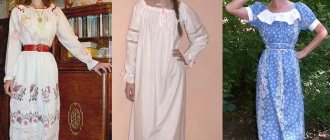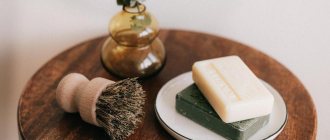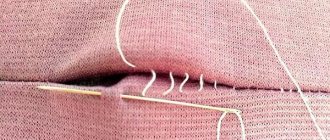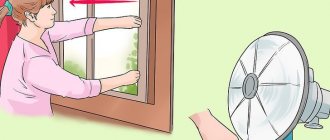Have you decided that you want to learn to sew, but don’t know where to start? The ability to cut and sew will come in handy in many situations when you need to hem a skirt, make new curtains or make a costume for a child for a children's party. Are you afraid that nothing will work out and you will waste a lot of time?
Cast aside these fears; you can learn to sew and master basic skills at almost any age. The main thing is to learn in a way that not only saves money, but also earns money.
Read our article to find out how you can learn to sew simple and fashionable things in one evening without much effort.
In this article we will tell you:
- Why do you need to learn to sew and cut from scratch?
- How to learn cutting and sewing?
- Is it possible to learn to sew and cut from scratch on your own?
- Tools needed for sewing
- How to choose a sewing machine?
- Useful tips for cutting and sewing
- Where to look for useful tips and inspiration if you are a seamstress:
Why do you need to learn to sew and cut from scratch?
Store shelves are filled with an abundance of dresses, but you still have to walk through them looking for the right sizes? Tired of buying your kids new clothes because they are growing too fast? Why then do you still not have tailor’s pins and a pattern in your hands?
Imagine how much you will gain when you learn to sew. You don't have to go to a tailor just to get your skirt or trousers adjusted. When sewing clothes for yourself, you and only you select the details of your future clothes: color, style, length, accessories. And what’s best is that each product will fit you perfectly. Don't forget about significant money savings and a pleasant pastime.
The ability to sew neatly and beautifully is an opportunity to make money from your hobby.
Do you think this is not true? Read our article and we will convince you otherwise.
Let's start from the beginning
There are several main professions in the sewing business: seamstress, tailor, fashion designer. Don’t think that once you learn to sew, you can only be a seamstress. Tailors and fashion designers know how to not only sew clothes with high quality, but also participate in the entire process of creating clothes - from idea to sewing.
Let's understand the terminology
Don't be alarmed when you see the word fashion designer . This is the name given to a specialist who creates patterns, knows how to select fabrics and sew professionally. He selects materials and decorative elements in such a way that even the most daring designer’s ideas can be realized.
So, choose what you want to learn and we will help you navigate.
Summer dress pattern
Now that you feel more confident, you can start sewing such a chic dress. Its pattern is also given for sizes 36-64 and height 4. The fabric is better than medium weight cotton.
The sewing instructions indicate that the dress is of “medium difficulty” level. But I think that if you coped with it and mastered the sewing of previous models, then you can cope with it, with the help of instructions, of course. The dress is very beautiful and the photos are inspiring. Is not it?
How to learn cutting and sewing?
Option 1. (for the motivated): Learn to cut and sew clothes professionally
In order to work in a studio or for yourself, you need to take into account that your main task is to learn how to correctly construct patterns. Then you will become a real cutter-fashion designer-designer.
You can become such a specialist by taking professional cutting and sewing courses. A full course must necessarily teach how to design clothes, work with professional equipment, and model clothes for different body types. During the classes you will develop practical skills (cutting, basting, sewing) and learn how to change the bobbin without outside help, learn many practical subtleties and secrets of sewing.
After careful preparation in the courses, you will be able to master any product.
Even such complex things as classic coats or formal business suits. You can get a job in a studio, sew clothes to order, or professionally create clothes for yourself.
Prices for professional cutting and sewing courses in Moscow and St. Petersburg start from 1,500 rubles and reach 25,000 rubles.
The duration of classes is from 40 to 150 hours.
Option 2 (for the budget conscious): Learn to cut and sew things for yourself and loved ones
For such skills, it is enough to take basic courses or courses on individual complex products, for example, coats, trousers or shirts. During your training, you will learn how to take measurements, cut and master straight stitching. This knowledge is enough to make your own patterns, adjust them to the desired size, choose fabrics, and cut out parts correctly. You can sew almost any item from your basic wardrobe.
Prices for basic cutting and sewing courses in St. Petersburg start from 2,500 rubles.
The duration of classes is from 20 to 50 hours.
Option 3 (for beginners): Try to make a pattern with your own hands and sew a simple but good thing
Try one-day sewing workshops on specific items. On them you will test yourself both as a seamstress and as a cutter. After completing the course, you will be able to sew with your own hands what you will wear every day or wear on holidays. For example, a fashionable sweatshirt, a new skirt or lace underwear. It's very tempting for the first time, isn't it? At the same time, you will understand whether it will be worth your suffering or not.
Prices for cutting and sewing master classes in St. Petersburg start from 1,500 rubles.
Duration of classes is from 4 to 10 hours.
Inspired and decided that you will take a cutting and sewing course? Great, the main thing is not to rush to buy the most beautiful lace or fabrics for dresses in the store. You should be more careful when choosing courses. If you decide to spend money on learning the profession of a cutter or seamstress, even from the very basics, it is worth taking as much as possible from the training.
- Try to find a master or studio with good reviews and a clear course program - this way you will know what you are paying money for and what skills you will acquire.
- There should be a maximum of 7 people in the course group - in this case, the master will definitely pay attention to you and help you if something doesn’t work out.
- Find out from the organizers what is included in the price and whether they will provide working tools during the training.
Apron pattern
Here's the apron. For those who do not want to deviate from the school curriculum. Why not sew for practice? Moreover, it is so wonderful, the price of the pattern is not high at all, and the sewing instructions are free.
Choose a dense fabric, preferably a mixed one. If you take pure cotton or linen, then your apron will unnecessarily absorb grease stains and wrinkle more than a fabric of a mixed composition.
Is it possible to learn to sew and cut from scratch on your own?
Yes - you can find many sites on the Internet with detailed instructions, patterns and tips. They will help you learn how to cut and sew on your own, even if you are starting from scratch.
Look for informational articles with photos or video tutorials that detail each step when cutting things. Nowadays, authors on any thematic resources conduct entire courses of video lessons, where they talk about types of fabrics, tools, types of figures, classic mistakes of beginners, and much more.
The following can help you learn how to sew and cut from scratch:
- thematic websites/forums about sewing;
- sewing magazines (Burda, ShiK);
- video tutorials on YouTube.
Of course, you may not be able to become a professional tailor by studying only at home, but you will definitely learn how to master basic cutting skills and get good at stitching.
Basic T-shirt pattern
And here is a pattern for a real basic T-shirt made of thick cotton jersey, with a set-in sleeve. Even complete beginners should not have any difficulties here. Everything is described in great detail in the sewing instructions for the pattern.
Size range from 36 to 60, 4 heights.
How to choose a sewing machine?
A good sewing machine is the most expensive and most profitable investment for a tailor or seamstress.
If you want to develop as a professional craftsman in the future, seriously think about purchasing a good sewing machine. A high-quality machine with all the functions and types of stitches necessary at the learning stage costs 6-10 thousand rubles. If you choose well, she will become your reliable friend for several years.
Look for your machine among the leaders in the production of sewing machines. European manufacturers include Bernina, Pfaff, Husqvarna , and Asian manufacturing companies include Janome, Brother, Juki, Jaguar . Singer are also appreciated .
We studied the reviews on Yandex.Market and found out that the following are good for beginners :
- Brother LS-300
- Plaff Element 1050S
- Janome 419S/5519
During training, you can buy a machine second-hand for training, and then purchase a more professional unit. If you still have your grandmother's old car, then try to start on it.
Common mistakes made by beginners
Don't start sewing hastily; this will lead to mistakes the first time. You definitely need to try on the item before you start sewing. You can’t start with complex fabrics. Leather and velvet require experience. Be sure to wet-heat treat the fabric, otherwise the item will be deformed during the first wash. You need to check how the machine works, whether the settings for the type of material are correct.
It takes more than just talent to learn to sew. Purchasing the right tools and sewing machine, practicing cutting, knowing fabrics, all this will help you quickly achieve the desired result.
Useful tips for cutting and sewing
It's no secret that the most important part of creating any costume is the pattern. It is also the most difficult. You won't be happy with a crooked seam, but fixing it is much easier than re-cutting the entire suit if you made a mistake with the calculations.
We have prepared tips for beginners that will help you avoid serious mistakes.
Remember them and make this practice automatic.
- Take measurements accurately. Understand the types of male and female figures. Watch video tutorials on how to correctly take measurements for different parts of the body. Then practice on your family members, or even animals.
- Create a pattern according to your measurements . Patterning is a labor-intensive process where you definitely can’t do something “by eye.” Specialized magazines will help a beginner to create a pattern, where there are ready-made patterns and all that remains is to transfer them to the fabric. Before starting work, you should watch video tutorials and start only with simple products.
- Learn the basic terms. You will search for sewing information, watch videos, and study magazines with patterns. Be prepared that you will have to know and use thematic vocabulary and understand the terms in advance. For example, find out how a lobe thread differs from a cross thread and why a cutting pad is needed.
- Practice straight stitching . Take the leftover fabrics and sew them together as your heart desires. Try making your own round potholders (a perfect circle is not that easy!), home textiles, clothes for toys and animals.
- Use thematic resources - get inspired, improve your skills, learn life hacks
- Find a mentor . Most often, people stop learning when the material is unclear and there is no help. Find an idol or mentor whose work you will be inspired by. Choose new ideas, experiment with patterns and outfits for yourself and your family. Don’t be afraid to write to special group blogs or ask questions under videos on topics that interest you.
Recommendations
When operating the machine, keep the following in mind:
- Cleaning the machine. Even the most stringent rules of cleanliness cannot ensure the complete absence of dust in the device, particles of threads and fabrics that, if accumulated, can disrupt the operation of the device. You can remove dust with wet wipes, brushes, tweezers;
- Adjusting the machine. Before starting work, you always need to adjust the “machine” and check it for serviceability. The process itself involves adjusting the stitching, that is, the tension of the threads;
Disassembling the machine
- Checking the machine's lubrication. Lubrication is necessary for all mechanisms and parts to work properly, smoothly and silently. To do this, use regular machine oil or lubricant specified in the documentation for the equipment. In it you can read what exactly needs to be lubricated;
- Job. If everything is done correctly, the lines will be even and straight. To do this, you need to constantly ensure that the cuts are aligned.
Machine lubrication process
Where to look for useful tips and inspiration if you are a seamstress:
- Groups on social networks with patterns, tips, selections of color palettes and much more (for example: DIY, a group with visual examples of patterns that can be downloaded, various home accessories and ideas).
- Video on YouTube - all the manuals with clear examples: rules for patterning complex things, with comments and instructions, decorating ideas, various master classes (for example: Easy to sew, a channel with which you can sew any children's things and toys).
- Thematic forums - here it’s easy to find like-minded people, ask for advice or ask for help with a pattern;
- Sewing magazines - trends for the new season, and many patterns that are not so difficult for an experienced craftsman to customize.
- In your free time, try to design your own clothing line. This simple practice of working out details and style will help you determine your preferences and better understand what kind of item you want to sew.
The main thing is not to be afraid - the head is afraid, the hands do. We need to take orders, even at a trifling price, and sew. Spit in all directions, in particularly difficult situations, drink a teaspoon of cognac with coffee, and continue.
It is also important to learn how to make patterns. If you can’t do it yourself, find someone who can teach you. Sometimes the product is completed in 2 hours, and sometimes something doesn’t work out at all. At this moment, there is a risk of making a bunch of mistakes that are difficult to correct. At such moments, I turn on Scarlett O'Hara with her "I'll think about it tomorrow."
Svetlana Ukhmakova, head of Atelier “Turn on the Lights”
Let's sum it up. How to learn to sew and cut from scratch? To do this you will need:
1) Decide for yourself what you want to be able to do: sew basic things or create patterns or make full-fledged sketches 2) Choose a mentor or inspirer who will help you get comfortable and point out mistakes 3) Practice and regularly sew on your own 4) Watch thematic video channels and groups 5) Look for new ideas for inspiration!
If you seriously decide to take up sewing, then don’t give up even after the first small failure. With proper practice, you will acquire a good practical skill that will allow you to create unique, beautiful things not only for yourself. If you wish, you can earn money by tailoring clothes, or, as a last resort, you can earn extra money in an atelier. Good luck to you!
This training may be right for you:
- Best Online Cutting and Sewing Courses from 1,100 Rubles
- 10 Best Cutting and Sewing Courses in Moscow
- Best Cutting and Sewing Courses in St. Petersburg
- 10 Best Lingerie Sewing Courses in St. Petersburg from 1,500 rubles
What to sew for a beginner
For those who have never cut out products or sewn them themselves, it is worth starting with simple operations - sewing a button correctly, overcasting a seam, temporarily connecting pattern pieces. There is no need to take on a complex product if you are not confident in your own abilities - it is better to hone your skills on small models (perhaps it will be hand-sewn clothes for a doll or baby).
The easiest way to make something that does not require a complex pattern. It is best for an inexperienced needlewoman to start with a pillowcase without fasteners. To sew a product 70 x 70 cm (the most common size), take fabric 72 cm wide (an additional 2 cm is needed for seam allowance) and 174 cm long (70 cm on both sides, 30 cm for the inner flap and another 4 cm for hem allowance).
Simple step by step instructions:
- It is necessary to bend the sections and stitch them.
- The fabric is placed face up.
- 70 cm is measured on the left side, and this edge is folded.
- On the right side you will need 30 cm for the valve, and this part of the product is tucked in the same way.
- The sections are stitched (joined), and the seam allowances are overcast (processed) with a zigzag stitch.
- The product needs to be turned inside out and the pillowcase will be ready.
Having mastered sewing a pillowcase, you can move on to making an apron. While working on this product, pattern making skills are well honed. The seamstress will be able to create her own sketch, but first it is better to follow ready-made patterns from magazines and books.
The next useful skill for housekeeping is the ability to sew potholders. This will allow you to learn how to work with dense materials, choose the right fillers and make beautiful seams (external stitches). It is better for an inexperienced craftswoman to start with square-shaped models. Only after this can you experiment with potholders of a non-standard configuration: in the form of a mitten, a butterfly, a bow, etc.
Subsequently, it is worth consolidating your skills and trying to sew a duvet cover, nightgown, napkins or other similar products. Only after this can you start making a skirt or dress.
Stitching
To pre-fit the cut out clothing parts, first sew them together using large stitches. Needles for such seams need to have a sharp tip; it is advisable that the eye of the needle be large - it will be more convenient to thread.
Making peony flowers from corrugated paper - a guide for beginners and a step-by-step master class on how to make a flower with your own handsHow to make a beautiful tree of happiness with your own hands: step-by-step master class for beginners (100 photos + video tutorials)
How to make a beautiful lampshade with your own hands: simple ideas for table and floor lamps (125 photos + video)
If fitting is not required, it is enough to pin together the parts for sewing by machine. When sewing a seam, the pins are removed from the fabric one by one - you must not allow them to get under the presser foot, otherwise the machine may malfunction. Then the seams are processed and run in a zigzag pattern.
It is very important to sew the parts correctly. Before sewing, the upper part of the sleeve must be gathered a little (maximum 1 cm), then the sleeve will stretch less when sewing with the armhole.
After turning inside out, flaps, collars and other parts must be ironed and only then sewn to the clothes. If you follow all these rules, you will definitely succeed.
Fabric selection
As already mentioned, cheap and natural cotton or linen fabrics with simple, smooth, lint-free surfaces are ideal for initial work and practice. After gaining experience, you can switch to more expensive silk or leather for bags and shoes.
A person trained in sewing will have no questions about what fabric to choose. Everything will depend on the budget, purpose and type of final item. A professional can choose from mixed (tisi, greta, tereda, sisu) or synthetic (viscose, acrylic, spandex) fabrics.
Fabric selection is a branch point of the sewing process
Important! As for patterned fabrics, they should not hurt the eyes and be very colorful. Otherwise, the figure will appear larger than it is. Especially in problem areas.
Cutting order
First of all, before the cutting process you need to make the necessary measurements. The afterbirth of this determines the silhouette of the product: tight, loose, hanging. Based on this, they make increases in freedom, length, and width.
Important! In order to make increases, you need to correctly measure the main indicators and body measurements and understand how to make increases to different measurements.
Pattern example
Next, you need to calculate the additional values that are needed to construct the pattern. For a dress, this is, for example, the width of the back and chest, as well as the width and depth of the floodplain. Calculation forms can also be found in the public domain.
You may be interested in this: Making patterns and sewing elephant toys
The pattern begins, which means you need a large sheet of paper, a pencil, a ruler and other accessories. To ensure that the drawing does not go beyond the boundaries of the paper, it is recommended to place the starting points 10-15 cm further from the edges in any direction. When the drawing is completed, you need to transfer the patterns for the back and front onto tracing paper and proceed to modeling.
Evening dress pattern


